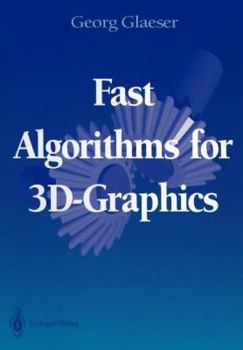Fast Algorithms for 3D-Graphics
Select Format
Select Condition 
Book Overview
In this book, a variety of algoritbms are described that may be of interest to everyone who writes software for 3D-graphics. It is a book that haB been written for programmers at an intermediate level... This description may be from another edition of this product.
Format:Paperback
Language:English
ISBN:0387942882
ISBN13:9780387942889
Release Date:January 1994
Publisher:Springer
Length:306 Pages
Weight:1.20 lbs.
Dimensions:0.7" x 7.0" x 9.3"
Customer Reviews
3 ratings
Good Educational Value
Published by Thriftbooks.com User , 20 years ago
This book provides a great educational resource for elementary 3D graphics. Even though the algorithms presented may be a bit simplistic compared to, for example, those used in the QuakeIII engine, they offer a great insight into the mathematics behind 3D graphics. C code optimization is also well presented in this book, but again a bit outdated, as modern compilers make macros for speed a thing of the past! This is a great book though, and ALL algorithms described have good mathematical background provided. You can also disregard the source code and use this just as a book on the math behind 3D graphics.Covered are: vectors, matrices, planes, lines, surfaces and all possible intersections thereof. Interpolation is also covered.I took the ideas in this book to write a very efficient C++ class library for my own use, and currently am rewriting for Java. This book is especially good if you only require wire-frame or simple shaded images.The book is also very good on the subject of C programming techniques (and tricks) alone (for those newbies who are scared of pointers, this book will convince you they're worth getting 'under your belt'!!), but as I said, with modern C++ compilers you'd be better off rewriting the code in C++. For example if you write a Vector class and overload the [] operator, all the macros will still work! In the book, they type a vector simply as array of float, ie a pointer, so a macro like:#define sub_vec2(ab, a, b)\ /* 2D vector subtraction */ ( (ab)[0] = (a)[0] - (b)[0],\ (ab)[1] = (a)[1] - (b)[1] )will still work with your class if you overload the [] operator, even though the macro was originally intended for float arrays!As said above, you get the same performance implementing the 3D operations (+,-,scale, magnitude, normalize etc) as member functions rather than (harder to debug) macros.A basic understanding of math and vectors/matrices would be an advantage before reading this book, but the equations are well explained.In a nutshell, this book is DEFINITELY worth a read, just don't expect to be able to write a cutting edge 3D engine from what you learn 8^)
valuable hands-on introduction
Published by Thriftbooks.com User , 25 years ago
For those who like a hands-on approach to learning a subject this can be an excellent intro to 3D graphics. Glaeser provides a minimal (and occasionally cryptic) introduction to the subject in prose alongside most of the C source code you will need to implement the concepts. He explains the ideas just enough that you can understand the code. But be forewarned: the floppy disk containing source code is fairly worthless. It does not correspond to the source in the text, it seems to be a much more advanced version of the system he developed on an SGI Iris running Unix. If you happen to have such a machine, perhaps you can get it to compile. But even if you did, you would have a "black box" consisting of a lot of code that is difficult to understand (and with very few comments). I decided instead to type in sections by hand, coming to understand everything I put in, fixing some glaring errors even before compiling, and bringing up sections incrementally. I also had to provide a good bit of my own code to actually make a functioning system. For me this was a good learning experience. The book is valuable but it would benefit by a second edition. The worst part of the book is the license for the software on the disk, which states that you may have no more than one copy and that "Springer-Verlag has the right to audit your computer". Since I didn't wind up using anything from the disk I take it that the license doesn't apply to me, but who knows? A new addition with an "open source" style license and a reworking of the organization would be very welcome.
Great book for understanding Graphics Programming
Published by Thriftbooks.com User , 25 years ago
If you're looking for a book to give you details of Graphics programming, I would strongly recommend Fast Algorithms for 3D Graphics. Although Fast Algorithms was originally written for Dos and Unix, I found the text and source to be complete enough to be able to port the source to any Operating System. The text and the code is easily readable; I enjoyed reviewing the real-time shadow algorithm in particular. After reading the book I was able to understand a lot of the graphics work being done while working at Alias/Wavefront. Since then I have become more interested in 3D Graphics and look forward to reading "Open Geometry", Prof. Glaeser's next addition. Over all, I found this book to reveal a lot technical questions I had about graphics programming. The code provided a real time solution to the questions at hand, not like other books that give snippets or pseudo code.






